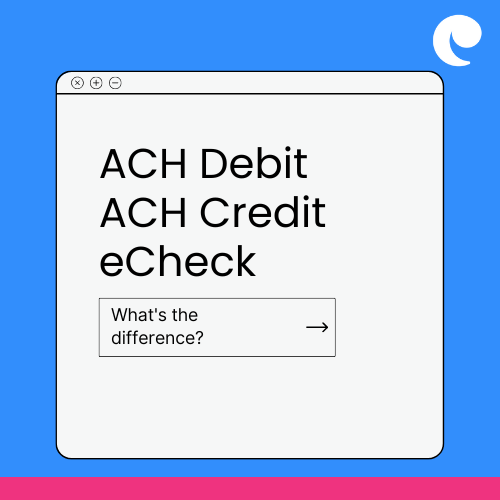Challenges in Accounts Receivable Management
Accounts receivable management is a vital aspect of financial operations for businesses of all...
By: Payference on Apr 3, 2023 11:14:26 AM

ACH Credit, ACH Debit, and eCheck are all electronic payment methods that are commonly used in B2B Payments. While they may seem similar, they differ in their processing methods, benefits, and drawbacks. In this blog post, we’ll explore the differences between ACH Credit, ACH Debit, and eCheck.
ACH Credit is an electronic payment method where funds are transferred from one bank account to another. This is done through the Automated Clearing House (ACH) network, which is a secure electronic funds transfer system in the United States.
The process of ACH Credit involves the sender initiating the transfer by providing their bank account information and the recipient's bank account information. The recipient then receives the funds directly in their bank account.
ACH credit is initiated by the paying entity and widely used to pay suppliers, bills and for direct deposit. ACH credit can take 1- 2 days to clear.
One of the main benefits of ACH Credit is that it is a secure and reliable way to transfer funds. It is also more cost-effective than other payment methods such as wire transfers or paper checks. Additionally, ACH Credit is beneficial for businesses because it simplifies the payment process and reduces the risk of fraudulent activity.
ACH Debit is another electronic payment method that uses the ACH network to transfer funds from one bank account to another. However, unlike ACH Credit, the recipient initiates the transfer by requesting payment from the sender. Many businesses use ACH debit via a customer payment portal, such as the one Payference offers, to collect payment from their customers in an efficient manner.
The process of ACH Debit involves the recipient obtaining the sender's bank account information and initiating the transfer. The funds are then automatically deducted from the sender's bank account and deposited into the recipient's bank account. ACH Debit transfers typically can take anywhere between 2-6 business days to complete.
ACH Debit is convenient and also beneficial for businesses because it helps to ensure timely payments and reduces the risk of late fees or penalties.
Both ACH credit and ACH debit payments offer benefits for B2B transactions. Some of these benefits include:
eCheck is an electronic version of a paper check that is processed through the ACH network. It’s essentially a digital check that is created and processed electronically. eChecks are typically used for one-time payments such as online purchases, bill payments, and donations.
The process of eCheck involves the sender providing their bank account information and the recipient's bank account information. The recipient then electronically processes the check, which debits the funds from the sender's bank account and deposits them into the recipient's bank account. eCheck transfers typically take 3-5 business days to complete.
One of the main benefits of eCheck is that it provides a fast and secure way to make one-time payments. It eliminates the need for paper checks or manual payments, which can be time-consuming and prone to errors. eCheck is also beneficial for businesses because it simplifies the payment process and reduces the risk of fraudulent activity.
CONCLUSION
In summary, ACH Credit, ACH Debit, and eCheck are all electronic payment methods that use the ACH network to transfer funds. ACH Credit is push based and primarily used for direct deposits, ACH Debit is effective for pull transactions, and eCheck is used for one-time payments. Each method has its benefits and drawbacks, so it is important to consider the specific needs and circumstances of each transaction when choosing the appropriate payment method.
ACH payments are an excellent option for B2B payments due to their efficiency, cost-effectiveness, security, and flexibility. They enable businesses to transfer funds quickly and securely between bank accounts, which can help to improve cash flow and streamline operations. Additionally, ACH payments can help businesses to save money on payment processing costs and reduce the risk of fraud. Overall, they are an excellent choice for businesses that want to simplify their payment processes and improve their financial operations.
Learn how Payference can help streamline your payment acceptance process and improve your cash application. Schedule a demo today!
Accounts receivable management is a vital aspect of financial operations for businesses of all...
Whether you're managing a small business or overseeing the finances of a large corporation,...
Are you among the many mid-size businesses that issue credit without requiring those customers to...